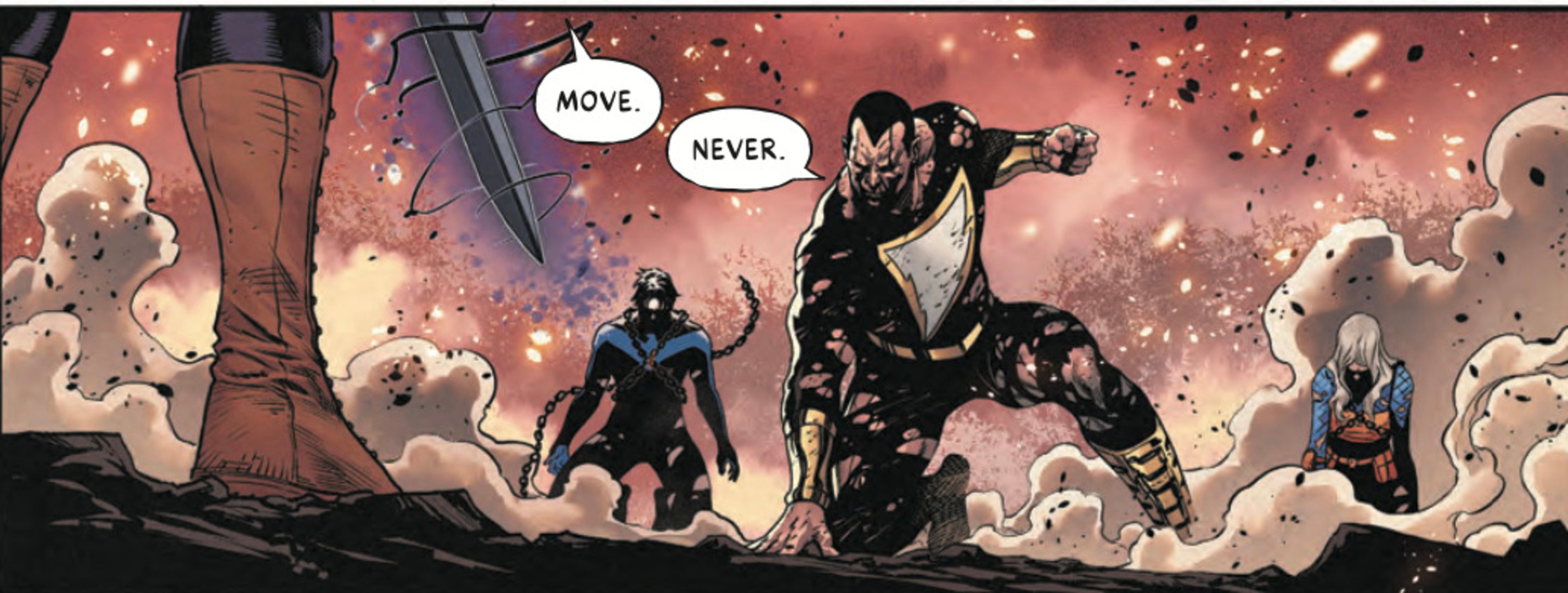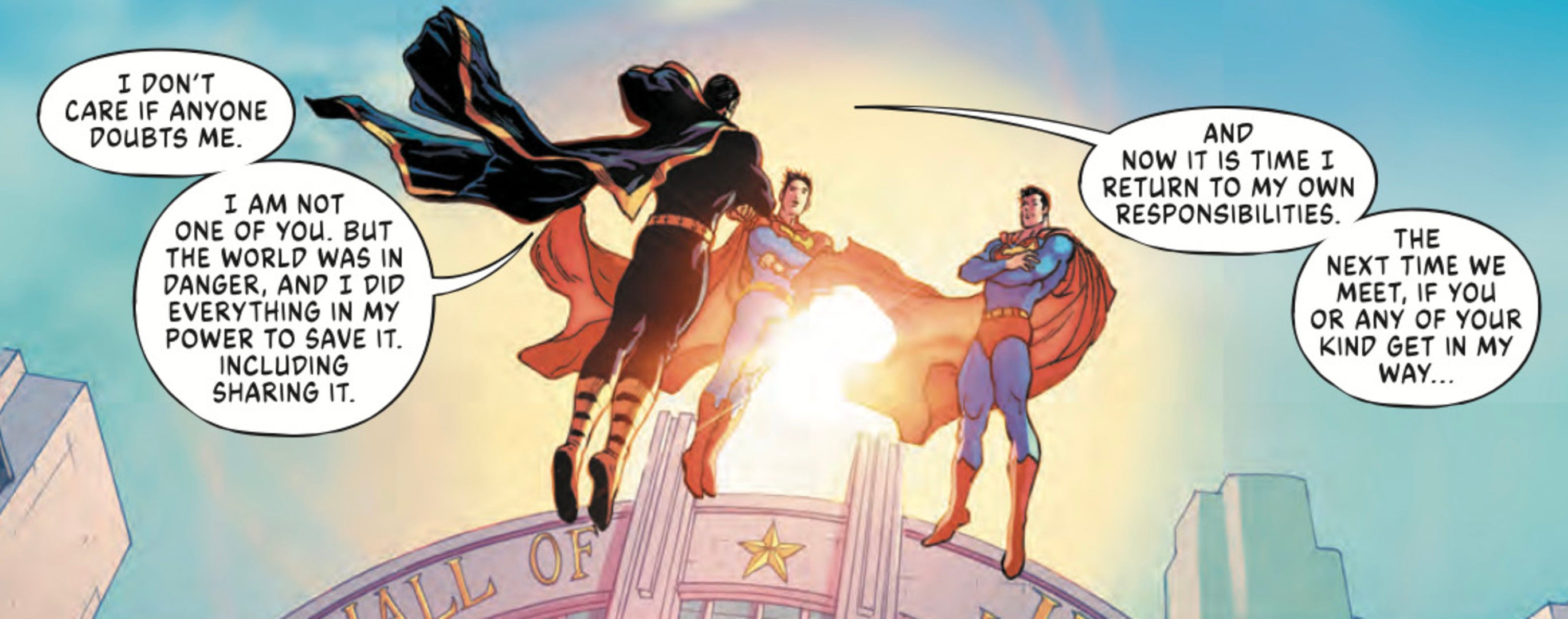If you click on a link and make a purchase we may receive a small commission. Read our editorial policy.
Dark Crisis: Black Adam’s long road to bonafide superheroism
As Dark Crisis on Infinite Earths reaches its explosive finale, Black Adam steps up to save the day but how did the magical antihero reach this surprising role in the first place?

One of the most important characters in Dark Crisis on Infinite Earths by Joshua Williamson and Daniel Sampere is Black Adam. The apparent sole survivor of the Justice League’s disastrous battle against Pariah and the Dark Army, Adam’s recent embrace of his superhero potential led him on a twisting journey across the DC Comics crossover event before playing a prominent role in the story’s climactic battle. And while Adam’s true allegiance was never particularly in doubt, his heavy-handed methods and ongoing critique of the surviving superhero community put on a journey to discover his own place in the DC Universe and if he truly belonged among the heroes he had battled against not so much ago.
Here’s a look at Black Adam’s vital role in Dark Crisis, culminating in him becoming the hero of the story, how this development affects Adam’s brush with redemption, and how Adam’s future in the post-Dark Crisis DCU remains as uncertain as ever.
Black Adam, hero of Dark Crisis

After barely surviving the Justice League’s brutal rout at the hands of the Dark Army, it was Black Adam who returned to Earth and informed the remaining heroes what grim fate had recently befallen their comrades. Though Adam initially had faith in Nightwing in rallying the heroes to step up and defend against the Dark Army, this confidence left him after Nightwing and the Teen Titans endured a harrowing defeat at the hands of Deathstroke and the Secret Society of Super-Villains. Further infuriating Adam was Jon Kent’s insistence to form a new Justice League, with Jon accepting virtually any hero who heeded his call to arms, to Adam’s vocal chagrin.
Recalling working with the Legion of Doom to save the day in the past crossover events Forever Evil and Dark Nights: Death Metal, Adam approached the supervillain team to take on their mutual enemy only for the Legion to be corrupted by the Great Darkness and siding with Deathstroke. The last man standing once again, Adam still had his misgivings about helping the heroes as they made their final stand against the Dark Army at the Hall of Justice. With the situation growing dire, Adam reluctantly shared his magical powers with the heroes to directly combat the growing darkness. As the empowered heroes turned the tide of battle, a weakened Adam confronted Deathstroke, besting him after a punishing fistfight while the cosmic conflict raged around them.
Black Adam, The obstinate champion

In a way, Adam personifies critiques regarding new generations of heroes not living up the legacies of the mantles that they inherit. Adam openly criticizes Nightwing becoming the superhero community’s new leader, the ragtag Justice League assembled by Jon, and Jon’s own attempt to live up to the role of Superman whenever Adam is given the opportunity. Frustrated by the perceived adequacy of the surviving heroes, Adam turns to his old associates among the supervillain community only to be disappointed by them as well.
Instead, it was Adam who was the x-factor in stopping the Dark Army all along, if he was only willing to literally make himself vulnerable and share pieces of himself to the world. There are a lot of themes going on across Dark Crisis and, for Adam, his character arc is one of acceptance and faith. Adam has to believe in this new generation of heroes enough to be willing to give them the magical boost from his own power supply to save the day while risking his life in a fight against the deadliest assassin in the DCU. Jon Kent and Nightwing bring hope whereas Adam is the skeptic who has to remember why he allowed himself to be counted among the heroes in the first place.
Black Adam, the DCU’s biggest antihero

Dark Crisis revolves around the journey of two popular characters widely perceived as antiheroes in the DCU, Black Adam and Deathstroke. Both characters carry their own respective codes of honor, have been known to occasionally ally themselves with the heroes when faced with a mutual enemy, and have bouts of working towards redemption on their own terms. However, whereas Dark Crisis confirms Adam as being a superhero with an admittedly antagonistic past, the crossover event cements Deathstroke’s status as a supervillain, eliminating any doubt if Slade Wilson is a truly bad guy or simply misunderstood.
After losing Respawn, the son he never knew he had in the crossover event 'Shadow War', Slade became obsessed with preventing any additional children to emulate the heroes, vowing to burn the Titans to the ground to make an example to everyone else to steer clear from following in superheroes’ footsteps. Conversely, while Adam felt the young heroes of the DCU were too immature and inexperienced to be effective, he saw them more as subordinates and overeager amateurs rather than moving to take them off the board.
Deathstroke is a character who has used, abused, and killed young heroes throughout his supervillain career, fueled by an intense self-loathing borne from losing or being resented by his own children. Black Adam is a character who has been handily defeated by children in the Shazam Family and learned to work alongside them, albeit vocally begrudgingly. Adam’s gradual capacity to learn to play well with others has led to a redemptive path that culminated with him joining the Justice League while Deathstroke’s flirtation with redemption during Williamson’s run on Deathstroke Inc. ended with him doubling down on his villainy and seizing control of the Secret Society of Super-Villains.
The uncertain future of Black Adam

After Deathstroke and the Dark Army have been defeated and the safety of the DC Multiverse seemingly secured, Black Adam’s place among the superhero community remains something of an open question. At the heroes’ behest, the Justice League has been disbanded for the foreseeable future while the community decides what path a reassembled team should follow when they inevitably reform. In a reversal from his previous dissatisfaction with him, Adam is complimentary of Jon Kent in the denouement – at least as much as Adam can be about him – but decides to return his focus to Kahndaq rather than get caught up in the affairs of the outside world.
Christopher Priest and Rafa Sandoval’s Black Adam maxi-series shows an Adam struggling with his own sense of mortality and willingness to share his magical powers with others, while staying on the sides of heroes – for now. Breaking bad would a major step back for Black Adam at this point in the character’s development but, as whenever Adam is involved, if anyone crosses with the Kahndaqi champion and his goals, they risk bearing the full brunt of his wrath, attempts at redemption aside.
Dark Crisis on Infinite Earths is written by Joshua Williamson, illustrated by Daniel Sampere, colored by Alejandro Sanchez, and lettered by Tom Napolitano, with an epilogue by a whole host of guest artists. The series is available in individual issues, with a hardcover collection slated to go on sale June 20 from DC Comics.
Dark Crisis on Infinite Earths has concluded, opening up endless possibilities for the future of the DC Universe. Here’s how the crossover event sets the stage for the Dawn of DC.
Follow Popverse for upcoming event coverage and news
Find out how we conduct our review by reading our review policy
Let Popverse be your tour guide through the wilderness of pop culture
Sign in and let us help you find your new favorite thing.
















Comments
Want to join the discussion? Please activate your account first.
Visit Reedpop ID if you need to resend the confirmation email.